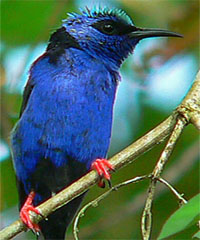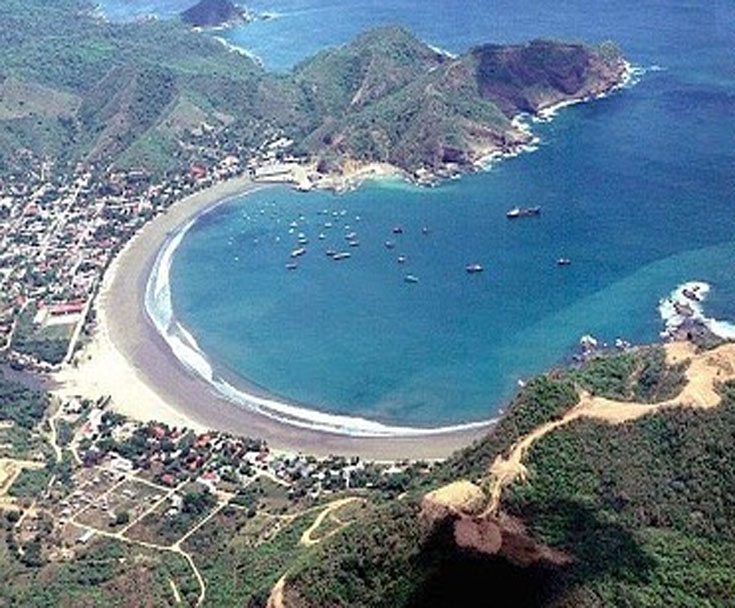Aerial View - San Juan del Sur, Nicaragua |
NEW! The Golden Gringo Chronicles are now available as a trilogy of novels NEW! Golden Gringo Chronicles Part 1 - Leaving the Homeland (Available Now)
|
Broken News
(All the News That's Fit to Reprint)
In last month's edition The Chronicles noted that Costa Rica and her current President, Laura Chinchilla, had given special recognition in February to the 200th anniversary of the birthday of former president Juan Rafael Mora Porras.
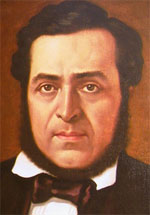 |
Juan Rafael Mora Porras |
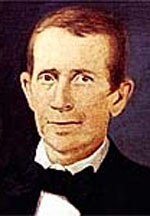 |
José Maria Cañas Escamilla |
Mora was an important figure in Costa Rica in the first half of the nineteenth century. He was President three times, was in charge of defeating the filibuster army of William Walker and was credited with introducing universal education to the country.
Unfortunately for Mora, he was deposed during his third term and exiled himself for a while in El Salvador. There Mora raised an army headed by his Salvadoran brother-in-law, General José María Cañas Escamilla as commander. He returned to Costa Rica in an attempt to reclaim the presidency, was defeated and summarily executed along with his brother-in-law, General Cañas.
History has been kinder to these gentlemen than were the peers of their time. Mora has become a national hero having plaques and postage stamps dedicated to him, while General Cañas now is the name of the very busy highway (and somewhat infamous road for bridge problems) between downtown San José and the main airport in Alejuela.
Time heals all wounds, as they say, except maybe the ones afflicted on Mora and Cañas in 1860.
Fiebre Estadio
"Stadium fever", no we're not talking about a new form of dengue, but the use of the relatively new National Stadium in San Jose. Since it's inauguration in March of 2011, it has been busy and become home to events that couldn't easily have been staged in Costa Rica in the past.
 |
"Sorry Coach, I'll Do Better Next Time |
A case in point is the World Cup of football, not the men's world cup slated for Brazil later this year, but the women's under 17 division which is playing in the new stadium March 15 to April 4 of this year (as well as four other stadiums about the country. Teams come from regional football divisions all over the world: Asia (AFC:![]() Japan,
Japan, ![]() North Korea,
North Korea, ![]() China PR); Africa (CAF:
China PR); Africa (CAF: ![]() Nigeria,
Nigeria, ![]() Ghana,
Ghana, ![]() Zambia); North America, Central America, Caribbean (CONCACAF:
Zambia); North America, Central America, Caribbean (CONCACAF: ![]() Mexico,
Mexico, ![]() Canada); South America (CONMEBOL:
Canada); South America (CONMEBOL: ![]() Venezuela,
Venezuela, ![]() Colombia,
Colombia, ![]() Paraguay); Oceana (OFC:
Paraguay); Oceana (OFC: ![]() New Zealand) and Europe (UEFA:
New Zealand) and Europe (UEFA: ![]() Germany,
Germany, ![]() Spain,
Spain, ![]() Italy). Costa Rica, of course, gets an automatic bid as the host country. Unfortunately, Costa Rica was eliminated because of two defeats in early play.
Italy). Costa Rica, of course, gets an automatic bid as the host country. Unfortunately, Costa Rica was eliminated because of two defeats in early play.
Hmmmm, I don't see the U.S. team listed under CONCACAF; our crack investigation team (guess who that is) will have to look into it.
 |
McCartney as a Beetle - "The Cute One" They Said |
 |
McCartney Today (After a Hard Day's Night) |
Three weeks after the tournament, the Estadio Nacional will be home to a rather unusual event. Paul McCartney will finish his Latin American Tour "Out There" with a performance in San José. Mr. McCartney was born one year before our hero, in 1942, and therefore is 71 years of age. (GG views that as seasoned, not old)
In addition to performances, McCartney's press advance states he has produced 24 albums since the Beatles broke up in 1975, many of which have gone gold. The man must be working "Eight Days a Week" and I guess he's just "Getting Better".
Tickets for the May event are offered at prices of 30,000 to 345,000 colones (~$60 to $675!) The stadium seats about 35,000 for football, but probably more, if needed, for a concert of this type. My guess is that it will be mostly full as Ticos (and a few Gringos) sacrifice to save up their Gallo Pinto money for a ticket.
I wonder if he'll perform one of his golden oldies that may relate better to Costa Rica like "Everybody's Got Something to Hide Except Me and My Monkey"?
¡Solo Bueno!
Spiney Spear Fishing
The Chronicles did a story in the September, 2013 issue on Killer Fish, particularly the Lionfish, which is invading many areas of the Caribbean. Lionfish are voracious predators and can significantly reduce the population of shrimp and shellfish in any area they take over.
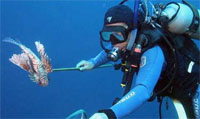 |
Spear Fishing Lionfish |
The appearance of Lionfish in this part of the world (originally they were only in the Indian Ocean and South Pacific) is believed to be a result of humans carelessly dumping the contents of their aquariums into the ocean. The solution to the problem may also come about because of human action.
Now comes a report that spear fishing may be the best method for controlling Lionfish populations and that a reduction of 75-95 percent of the population in any area will allow a fast recovery of the native fish species. Tournaments are now springing up around the Caribbean to encourage Lionfish population control.
It helps also that Lionfish make good ceviche, but be careful, it should only be prepared by those who know how to avoid the poison sacks and venomous spines.
Rumble Talk
(Shaky Happenings On or About the Pacific Rim)
Unbuilding Puntarenas Hospital
The 50th Edition of the Chronicles, October 2012, narrated an unusual experience our hero had the previous month when he found himself in the middle of the second strongest earthquake in Costa Rican history less than 20 miles from its epicenter. GG was caught on the first floor of the 10-story Puntarenas Hospital waiting on an eye exam when the tremor hit.
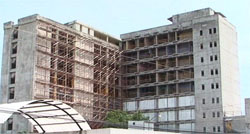 |
Puntarenas Hospital Being Prepared for Partial Demolition |
In the first months after the incident, government officials hoped to find ways to repair the much used and much needed hospital but by mid-2013, engineers had concluded much of the structure was beyond repair. The plan now is to remove the top seven floors, leaving the bottom three floors for out-patient treatment and diagnostic facilities. All the building's windows must be removed before the careful demolition continues and some patient services will continue on the first floor while demolition goes on.
GG passed through puntarenas recently on the way back from Nicaragua (the Puntarenas/Quepos bus passes right by the hospital) and noticed the bricks and cement blocks for the tenth floor had already been dismantled (picture right in somewhat earlier and does not show this).
The government has obtained a $270 million loan from a regional development bank to fund a new hospital and add facilities to other locations in Costa Rica. The new Puntarenas Hospital will be built on about 15 hectares (38 acres) not far the old facility. Artist's rendering and expected completion date have not yet been released.
| Check Out Recent Earthquakes Around the World Posted by the U.S. Geodetic Survey: Today's Quakes |
|---|
How to Make Round Stones
(The Power of Moving Water)
Growing up on the Atlantic coast of the U.S. northeast , and living through at least 15 hurricanes during his formative years, GG learned to respect the power of water early in his life. He later lived along the Ohio River, also a very powerful stream, for another ten years. Whether it's 30 foot waves pounding the shoreline and carrying houses away or a broad and deep river like the Ohio in flood stage washing away homes and flooding businesses, large bodies of rapidly moving water need to be approached with caution.
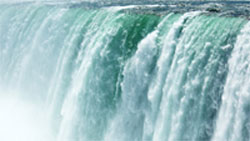 |
Untapped Energy Source |
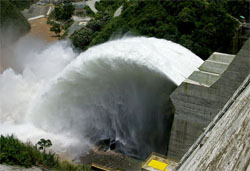 |
Pirris Hydroelectric Plant - Los Santos Region, South of San Jose |
It's all about energy, of course. First there's kinetic energy, the kind of force that's derived from large amounts of water moving quickly in a specific direction. Then there's also potential energy that is related to gravity and derived from the water dropping vertically. Taking advantage of both these types of energy release is the reason and motive behind hydroelectric power.
Costa Rica is a natural for extracting both types of energy. Typically, the country receives 200-240 inches of rain per year, as much as five times that of the region where GG grew up and even up to three times that in Florida, the most sub-tropical of the continental U.S. states. These heavy rainfalls during invierno (winter) result in a large number of strong flowing rivers throughout the country.
Much of the water also comes from streams formed high in the mountain ranges well above sea level, adding an extra kick of potential energy to the mix. And the extraction of the energy as hydropower is relatively clean except for the temporary rearrangement of the land to build the plant, an activity that often generates controversy.
Costa Rica has been taking advantage of this type of energy since the first plant was built in the early 1900's. In 1949, with the completion of the civil war that brought the current constitutional democracy to the country, a national electric company was formed called ICE (pronounced ee-say) or Instituto Costarricense de Electricidad. ICE is still a virtual monopoly for the distribution of electricity in Costa Rica but gradually other, private companies have been allowed to develop projects also. There are now some 60 private hydroelectric projects in place throughout the country at this time, some constructed, some under construction, .
Theoretically, after the initial capital cost is paid for, this form of power generation should be cheaper; the fuel raw material (water) is quite cheap, right? But anyone who has lived in Costa Rica and paid an electric bill knows that isn't true. GG's own personal experience is that he pays more, on average, for a small two-room apartment (~ 400 sq ft) for electricity than he paid for a two-bedroom apartment (~1100 sq ft) in Florida. Part of that is due to the relative newness of the hydro plants, part of it is due to having an old air conditioner here versus a heat pump in Florida but some of it is also due to higher per kilowatt charges which are unexplained. Even though hydro accounts for more than 80% of electricity production, the growth of demand here is forcing more use of expensive carbon fuels as new hydro construction can't keep up with the demand.
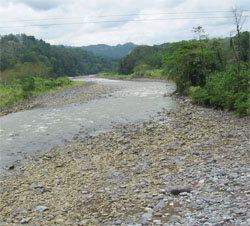 |
Nearly Dry River Bed Near Cerro de Muerte Central CR |
There is also a seasonal effect. During the Costa Rican summer ("verano"), January through April, many rivers virtually dry up or their volume slows down considerably. The picture to the left shows a river bed that is nearly dry. GG's guess is that that picture was taken at the end of the dry season, probably late April or early May because the gathering clouds in the picture would indicate approaching rains.
When the water drops and the flow to the hydro plants abates, it forces the electric company to add considerable fossil-based generation to the mix increasing overall generation cost. Electric bills to the consumer go up during these months. The rates don't moderate again until we get well into the rainy season.
Rates in 2013 jumped by 24% over the previous year and are likely to jump another 10% this year. Rate increases on average have increased by a compounded rate of over 16% in the last fifteen years. Despite all the efforts towards hydro and solar, fossil fuels will be in the mix for a long time and Costa Rica has no domestic source, nor are they willing to develop any. Ticos must rely on oil/fuel imports for along time to come.
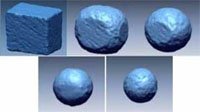 |
The Process of Water Abrasion on Rocks |
Another way water is powerful is in its erosion capability. Rivers cut through rocks and make gorges. We have some of the prettiest gorges in the world here - just drive or take the bus from the coast across the autopista to San José or go deeper into Monteverde, the rainforest and a half dozen other locations, like the road from Dominical to San Isidro.
In addition to the macro effects on the landscape like gorges, water also forms and shapes smaller things, like rocks. Geologists have known for a long time that rocks tend to be rounder and smaller as one proceeds downstream. Now, a study and report from the University of Pennsylvania (go Nittany Lions) using mathematical models shows how water abrasion of rocks happens in two stages. First the unequal surfaces become rounded and then and only then the diameter of the rocks is slowly reduced.
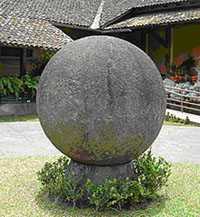 |
Stone Sphere at National Museum in San José |
This finding has renewed speculation that this might be the process that generated the mysterious solid rock spheres attributed to the pre-columbian indigenous peoples of southwestern Costa Rica (see Balls of Stone).
Up until now these spheres were thought to be man made but maybe there was a natural cause. All kinds of theories and proposals were put forward on how natives could have achieved such perfect dimensions on the spheres. Some of the stones have been found in various formations indicating that they were moved and suggesting that they were used in religious or civil ceremonies.
Could these spheres actually have been made by water abrasion of boulders in the big rivers rather than carved by the indigenous natives? Is it coincidental that many of these spheres have been found in the lower delta regions of major rivers like the Diquis' river delta in southern Costa Rica?
This previously un-thought of cause for the mystery spheres seems like a possibility now. More will be revealed as the research continues.
¡Pura Vida!
Navigating Nicaland
(San Juan del Sur and Granada)
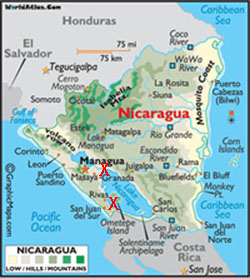 |
"X" Marks the Spots for San Juan del Sur and Granada |
In March, three of the ROMEOS decided set out on another adventure and headed north for a week with the intent of exploring Nicaragua, particularly San Juan del Sur on the Pacific side and Granada which is situated on Lago Cocibolca (best known as Lake Nicaragua), some 50-60 kilometers north of San Juan. Exploring the capital, Managua, would have to wait for another trip.
On the map, it doesn't look that far to go (this, of course, is one of the most common and dangerous statements about travel in Central America one can make). Checking Google Earth, from Quepos to Granada seems to be about 360 kilometers or 210 miles as the raven flies and maybe about 50-60 kilometers less to San Juan del Sur. On a U.S. Interstate 80 type road we're talking about 4 hours travel, right? In reality, it would take us a total travel time of about 12 hours.
We first went to San Jose via the public Directo bus from Quepos - three hours flat. We had tickets for the Ticabus (a private Costa Rican bus company) that left at 7:30 AM the next morning. In order to make that bus the same day from Quepos we would have had to take the 4 AM bus (ugh), and the connection would still be too close for safety.
 |
The Ticabus |
We stayed overnight at a hotel near the National Theater, close to a number of good restaurants and only a ten minute cab ride to the Ticabus terminal where we had to be at 6:45 AM the next morning for check in. Good dinner, good night's rest and we were at the terminal 45 minutes before departure as requested by the bus company.
The bus got off about ten minutes late, not sure why (maybe just Tico time, amigo). The bus route heads out of San José along the General Cañas highway that goes to and by the airport. Eventually, the bus turns northwest onto the Interamericana (Pan-American Highway) and takes this highway all the way to the border and beyond. In Nicaragua it passes near San Juan del Sur and eventually goes into Granada as it winds north.
GG had made this trip once before in 2009, using a visit to Granadain order to obtain a 90-day visa renewal. At that time he used the Transnica Bus, the Nicaraguan equivalent of the Ticabus (for simplicity let's call it the Nicabus). The Nicabus stopped at a restaurant about three hours out of San José where we had time to take a breakfast while overlooking the mountains. The Costa Rican version had the driver stopping to let on a (friend) vendor to sell us sandwiches and beverages. Notwithstanding the potential safety situation it created because of the vendor's coolers and equipment blocking the front exit of the bus for almost an hour, watching the vendor pour hot coffee while standing in the aisle of a rolling and lurching bus was great entertainment (where are the anti-McDonald's lawyers when you need them).
In retrospect, GG has to give overall higher marks to the Nicabus over the Ticabus. The Ticabus stopped more frequently, not to let off passengers, but to let vendors on and off, to have some unexplained conference between the driver and some dudes in Ticabus uniforms in the middle of nowhere and a couple of times for no obvious reason. Both of these busses have WC's (sort of like using an airplane baño in heavy turbulence, but on the return Ticabus the bathroom was stuffed with some kind of freight that made it virtually unusable (I wonder of the shippers also knew their freight was under threat of spoilage). The net result was the Ticabus added one to one and a half hours onto the trip over the Nicabus.
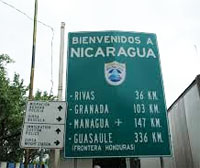 |
Nica Welcome Sign |
It took us almost five hours to reach the Peñas Blancas border crossing. The name means "white cliffs" as evidently there are some interesting rock formations in the area but we didn't get to see them. It took another hour and a half to two hours checking out of Costa Rica followed by checking into Nicaragua. In the first instance, all passengers are dropped off at the Tico checkpoint and all that's needed is to present a passport and customs declaration to get an exit stamp in the passport.
After checking out of Ticoland all passengers then return to the bus and the bus slowly moves forward about a quarter mile to the Nica checkpoint. In the meantime, the bus staff has collected all passenger passports, two more customs forms and an ingress tax of $14 per person. (Note: The new, controversial Tico land exit tax of $7 was never mentioned so we didn't pay it) The Nica part of the border crossing also requires exiting the bus with all baggage for customs inspection, although in just about every instance the search was perfunctory.
It had been suggested by a friend to exit the bus in Rivas, a small town 36 kilometers north of the border, and take a taxi to San Juan, which we did. Rivas holds a special historical significance for Costa Ricans. It was the place where the Tico legendary hero, Juan Santamaria, (the main airport in Costa Rica is named after him) defeated that no-good Philadelphia lawyer-come-filibuster William Walker when the latter decided it would be a good idea to crown himself King of Central America in the mid-1800's. Walker was later hung by the Hondurans (evidently they too had little respect for Philadelphia lawyers).
GG had mentioned to the bus driver at the border that we wanted to get off at Rivas. The Tico driver, as is traditional, immediately informed me that he had a "friend" taxi driver in Rivas that would take care of getting us to San Juan del Sur, which he did in a friendly way and at a fair price. What GG didn't realize was that getting to San Juan from Rivas involved taking the Interamaricana half way back down to the border and then 20 kilometers west on an access road to the beach town. In retrospect and for future reference (FFR) it would have been just as easy, maybe easier, to take a taxi from the border directly to San Juan.
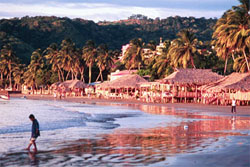 |
San Juan Bay, High Tide at Sunset |
San Juan del Sur is built within a large, mountain-lined cove making it a pretty good port. Many of the tourist hotspots (restaurants and night clubs) are built on the water's edge of the crescent shaped beach (see the header at the TOP of this edition for an aerial view). At high tide, water literally laps at the base of the popular restaurant and night spot section and the beach is reduced to a patch on the northeast section.
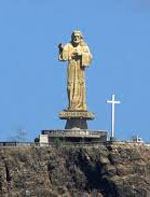 |
El Cristo de la Misericordia, San Juan del Sur |
On one of the mountains forming the bay to the north of town, facing south towards the town is a large statue of Jesus, purportedly the largest in Central America and the fourth largest in the world. It overlooks the main town but the back of the statue is also clearly visible from the hotel we stayed in, which was several kilometers outside of town. (GG forgot to ask the question as to why the statue isn't of St. John; I guess JC pulled rank)
Our taxi driver gave us a spontaneous, 3 Córdoba (10 US cents - just kidding, actually, no charge) tour of the downtown area. Córdobas are the Nicaraguan currency, 25 to the dollar currently, up from 20 in 2009. San Juan del Sur is a small town, estimated at 15,000 population by the taxi driver or about two times Quepos. But, like Quepos, virtually all the town businesses are just a quick walk.
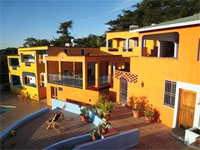 |
Hotel El Jardin |
In our pre-planning, we had been unable to find a downtown hotel in our budget range, so we ended up at a hotel called the El Jardin, a few kilometers northwest of the town center. Half of the access road was unpaved and rough, and required us to use taxis every time we went to town, but the local taxi drivers were game for the fare, even if it meant scraping bottom a couple of times per trip. The hotel was situated about 2/3 of the way up a mountain and provided for a spectacular view, this time of another cove and bay below that is not generally open to the public. The fare worked out to be about $32 per night per person.
The rooms were sparse (no TV, no phone) but clean and comfortable, once two large spiders (closer in size and hairiness to tarantulas) were removed from GG's room, one by the manager and one by GG. GG noticed that each room came equipped with a large can of Raid. One feature all the ROMEOs enjoyed was the open air breakfast room (center in the picture above, right) with a great view of the bay and nearby hills.The hotel manager, a French dude named Ton-ji (tawn-hee), who was called Tony by everyone, was quite helpful. Tony surprised us as we arrived by saying the triple room we had reserved didn't exist; GG suggested that this was his problem and he quickly provided a second room at no charge. He was also very helpful in keeping us supplied with ice water and arranging taxis at the best prices, including the one that would take us to Granada later in the week.
We had several meals at the restaurants along the waterfront while we were there, all good. Most meals were inexpensive (the one that wasn't is described in the ROMEO Review below). Seafood offerings seemed to dominate the menus and we enjoyed good lobster tails at low prices (two for 150 Córdobas or $6 in one place). Of course, GG also quickly learned the location of the biggest ice cream parlor in the town (Eskimo - north end of the beach - not as good as POPS, but good nonetheless).
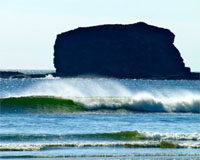 |
Playa Hermosa Near San Juan del Sur |
GG was, perhaps, the biggest beachophile amongst the three ROMEOS (my non-Webster definition of beach-o-phile is: hopelessly and magnetically attracted to ocean, sand and surf). Our hero has been spoiled by beaches like Siesta Key, Florida and Manuel Antonio. The only disappointment in the visit to Nicaragua for GG was the relatively difficult access to the kind of beach on which he's hooked.
The town beach is what I call a harbor beach, reminiscent of Caldera near Puntarenas or, in a smaller way, Quepos Beach. We did attempt to take a shuttle to Playa Hermosa, as several people said it was the prettiest in the area. We were told that it was a half hour down the coast over an unfinished road, but when we showed up the next day to take the shuttle, they informed us they needed a minimum of four. We never got there. It appears that many of the beaches in the area are surfing beaches with the waves suitably sized. One of the things GG likes about Manuel Antonio is that most of the time it isn't a surfing beach (although many Minnesotans think it is). OK, it's a old versus young man mental thing, I admit.
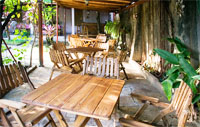 |
Interior Courtyard at the Kekoldi Hotel - Granada |
We stayed three nights in San Juan del Sur, from Tuesday afternoon to Friday morning and then took a taxi to Granada ($50 for about 50 miles or about $17 per person). We stayed at the Kekoldi hotel in Granada, located three and a half blocks west of the central park and square, which is the heartbeat of the city. The triple room we had was comfortable, air conditioned and included a TV; the fare worked out to be about $25 per night per person.
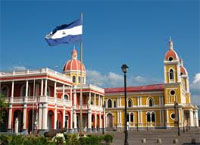 |
Granada Central Square Architecture and Cathedral |
Granada is much larger and more populated than San Juan del Sur, estimated at about 120,000 and offers a greater variety of amenities and culture as a result. It has, for example, some of the best examples of Spanish colonial architecture in Latin America. It also has the home, now a museum, of our friendly filibuster William Walker, whose mischief was mentioned above.
The most recognized and remembered street in Granada is Calle Calzada. This wide boulevard, half of which is a walking street, runs from the central square and park near the cathedral about one kilometer east until it reaches the shore of Lake Nicaragua. Hotels, shops (including another Eskimo ice cream parlor), bars and restaurants abound on this street.
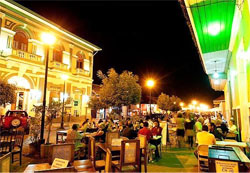 |
Calle Calzada at Night |
At night, Calle Calzada turns into a combination of Bourbon Street and the Champs Elyseé. Puppeteers, clowns, acrobats and drummers abound - sometimes the noise is a bit much but entertaining nevertheless. Restaurants scatter tables across the wide sidewalk and into the street if necessary to accommodate diners. Hundreds and hundreds of people mingle wherever they can find a space or just walk up and down the center of the thoroughfare aimlessly, dodging the entertainers. Dozens and dozens of vendors, including many underage, pry their wares table to table trying to sell everything from a grasshopper formed out of a palm frond to jewelry to paintings. They are persistent and sometimes require a firm "No" or "No moleste" to get them to move on. The younger ones are too cute and will eventually wear you down.
Being on the lake of course means their is no ocean beach. And a local confirmed what GG had been told on is previous trip there in 2009, i.e., no swimming is suggested on the narrow beach in front of the town because of pollution. The best beaches are out on the islands, Ometeppe Island being the biggest and best of them. We checked the ferry schedule to Ometeppe only to learn the trip one way was four hours and most people make the journey into an overnight stay of at least one night. FFR - perhaps the next visit. FFR - to diary, improve your pre-planning.
One of the ROMEOs decided to stay on for a while, while two of us went back to Costa Rica on the Ticabus. The returnees decided on a different strategy to avoid San José by taking local busses from Liberia to Puntarenas and then down to Quepos. When we told the bus driver we wanted to get off the bus at Liberia to go to Puntarenas, he said: "Oh no, señor, get off at Baranca, it's much closer". And so it was; Liberia to Baranca was another hour and a half (probably 120 kilometers) which means Puntarenas was at least that far from Liberia. We took a quick taxi from Baranca into Puntarenas and caught the T.Q.P. (Transportes Quepos Puntarenas) bus within an hour. We were home by 4:30, a total elapsed travel time of 9 hours versus the 12 we spent coming up.
(FFR - probably the best route on a future trip would a T.Q.P. bus to the Robles station just south of Puntarenas, then a local bus from there (or Baranca) to the Peñas Blancas border crossing and then a taxi to San Juan - might be as little as 7 or 8 hours)
Although the three of us may have all had different reasons for taking this adventure, all came away with a pleasant feeling for having made the trip. Whether you want to evaluate Nicaragua as a possible place for retirement or just visit, southwestern Nicaragua is fun to explore.
¡Deacachimba! (See the What's-in-a-Word section below for the meaning of this word)
Santa Muerte
(The Saint of Death - Mexico)
 |
Captured Kilo of Cocaine With Picture of Santa Muerte On It |
A recent press report said that some 83 kilos of cocaine (U.S. street value about $25 million) was seized by Costa Rican Fuerza Publica agents from smugglers trying to get their product through to El Salvador and then probably Mexico and the U.S. The stuff was under the floor of a public bus. The report didn't say what bus company was involved but Ticabus, the one the ROMEOs took to Nicaragua, is also one of the most popular busses on the San José/San Salvador route.
One of the interesting things about the one-kilo bags in this shipment was that on each one was a picture of Santa Muerte, "Saint Death". Santa Muerte is described as a female folk saint and is a concept that derived its origin in Mexico amongst the pre-columbian natives as their culture morphed into Catholicism.
The practice of venerating Santa Muerte, long condemned by the Catholic Church, still has a hold in some mesoamerican culture, including certain people that are considered "outcasts". Although Mexico is still the center of this culture, the practice can also be found in some Central American countries as well as in some parts of the southern United States.
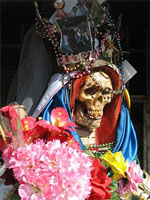 |
Also a Santa Muerte |
The official title of the "saint' is Nuestra Señora de la Santa Muerte or Our Lady of the Holy Death. Although she personifies death, devotees associate her with healing, protection and a safe delivery to an afterlife. It is thought that that's why the smugglers put a picture of her in the bags of cocaine; they don't expect to live a long life in their business.
There is further symbolism in the varied representations of Santa Muerte. She is often pictured with a scythe and a globe (like on the cocaine bags above), the former indicating the instrument of death and the latter symbolizing her dominance over the world. She also is often depicted as a skeleton and may be embellished with rich clothes, gold, jewels and flowers just like other saints. You can even find statues of Santa Muerte for sale on Ebay: http://www.ebay.com/bhp/santa-muerte-statue.
The press report quipped that the drug cartels might want to get another saint as this one didn't do a good job of protecting their coke assets.
¡Pura Vida!
What's-in-a-Word
Mora, Cañas
GG has always enjoyed learning the English equivalent of foreign language words. A case in point are the former Costa Rican president and his brother-in-law mentioned in the lead article in the Broken News section above. Juan Rafael Mora Porras sounds so formal but if one knows that mora is Spanish for "blackberry" it would be logical to call him Johnny Blackberry (sounds like a good name for a cell phone).
Juan's (Johnny's) brother-in-law, José María Cañas Escamilla also has an interesting equivalent. Cañas, his main family name, translates to cane, like in sugar cane (or maybe Anglicized to caine). Joey Caine's last name (his mother's), escamilla, means "a small scale". Joey da Small Scale Caine sounds like someone from Newark who shorted everyone on the weight of something.
Granada
A few ROMEOS were sitting on the beach recently when someone asked what the Spanish for pomegranate was. A quick referral to the I-phone translator produced the translation as "Granada". Get the heck out, we were just in Granada, Nicaragua and no one explained that!
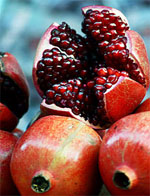 |
La Granada |
So GG looked up the etymology of pomegranate. It comes from the medieval Latin pōmum "apple" and grānātum "seeded". The latin influenced the use in many languages(e.g. granada in Spanish, Granatapfel or Grenadine in German, grenade in French, granatäpple in Swedish and pomogranà in Venetian. Perhaps the modern word came from the old French word for the fruit, pomme-grenade. The pomegranate was known in early English as the "apple of Grenada" - a term which today survives only in heraldic blazons.
We know that Granada, Nicaragua was named after the Spanish city. Now we know that the ancient city of Granada in Spain was renamed after the fruit during the Moorish period. Spanish colonists later introduced the fruit to the Caribbean and Latin America, but in the English colonies it was evidently not planted.
¡Deacachimba!
This is a peculiarly Nicaraguan word used somewhat like the Tico ¡Pura Vida!In the modern vernacular it can mean awesome, cool and is often used like the crude term in American English, "effin-A, man". So it's used more on the street rather than in the home, church or school. An example: "Look man, I just found a hundred bucks!" "Deacachimba!".
ROMEO Corner
(Retired Old Men Eating Out)
El Timón, San Juan del Sur, Nicaragua
Location: On the bay front, just left of where the main town access road tees with front street.
Hours: Breakfast, Lunch, Dinner Monday through Sunday
Parking: On the main street.
Contact: Tel.: (505) 2568-2243; Email: N/A; Website: www.eltimonsjs.com
Reviewing ROMEOS: Dennis P., Bob N.
To Review Our Rating System and Procedure, go here: R.O.M.E.O. Rating System
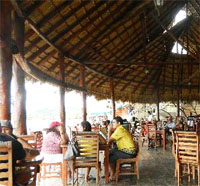 |
Dining Room at El Timón |
During our taxi ride from Rivas to San Juan del Sur we asked our driver if he could recommend one or more restaurants in San Juan. He rattled off three quickly and at the top of his list was El Timón.
El Timón in Spanish refers to the pilot wheel in a ship's wheelhouse adding a nautical theme to the place. The restaurant is easy to find as the wall on the street-side has a pilot wheel mounted on it and the place is located right on the main drag that runs along the beach. Another landmark is the very high thatched roof that gives it a bit of a polynesian look.
The restaurant decor is what GG often calls at home Tico eat-in-the-rough; hard wooden tables and chairs (a little padding on the chairs for GG's bad back) and very simple table decoration. The room is open to the atmosphere and the ocean was lapping close to the edge of the restaurant while we were there so it must have been high tide. Only two ROMEOs made it to this particular dinner because one had taken ill with a stomach condition (resolved the next day with the aid of a doctor).
The menu offered an extensive list of seafoods, meats and specialty dishes with a Mexican and/or spicy flair; it seems Nicas tolerate (prefer?) more spice on average in their food than Ticos.
GG chose two seafood dishes. The first course consisted of thin slices of octopus covered with a light, soy-based sauce; delicious. For the second, I chose one of their specials; two medium sized lobster tails grilled and drenched in garlic butter. Served with the main course (a bit after the fact) was the inevitable small side plate of plain white rice and some french fries (must be a Centroamerica thing and not just Tico to serve two relatively bland things, and starches at that, with a meal. The same accompaniments showed up for my dining partner's steak. My dining partner went for a steak and it came covered in fried onions. GG got to sample a piece and it was tasty and tender. We came to learn, both here and in Granada, that local Nicaraguan beef is much more tender than typical beef in Costa Rica (¡deacachimba!). GG had a filet in Granada that was the best piece of beef he'd had in many a moon. |
 |
|---|---|
$$$ |
|
Value Index = 133 |
The service was friendly, polite and timely. For atmosphere, food quality and service we give El Timór four sloths.
GG's remembers paying a bill for slightly over 700 Córdobas (about $28) for the two seafood dishes. After returning home and thinking about this for a while, it seemed that the 700 figure is out of line with the general situation encountered in Nicaragua. My dining partner's bill for the steak and a beverage came to 350 Córdobas or about $14. My filet in Granada was 400 or about $16. Either I paid a bill at El Timón for the combined dinners and my partner also paid a second time for his or the experience was just another senior moment; I prefer to think it was the latter. We give El Timón three $ for a cost rating (remember this is in relation to a Quepos/Manuel Antonio standard). The Value Index is therefore, 4/3x100 = 133, putting it in the top third of all our value ratings.
So, if you find yourself in San Juan del Sur, be assured that you won't starve and you can count on a good meal at a value price at El Timón.
TOPdon Beto de Quepos,
El Gringo Dorado Pura Vida! |
Be pithy but kind. I'm sensitive. |
|---|
